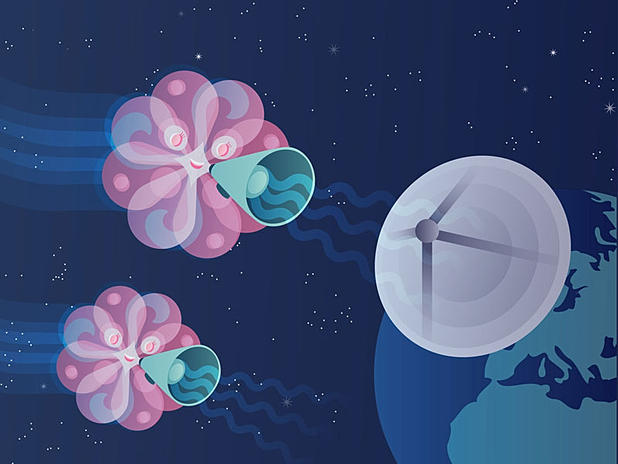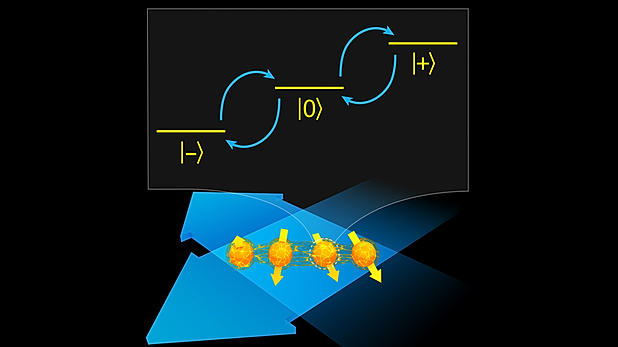
Invisible dark matter accounts for 85 percent of all matter in the universe, affecting the motion of galaxies, bending the path of light and influencing the structure of the entire cosmos. Yet we don’t know much for certain about its nature.
Most dark matter experiments are searching for a type of particles called WIMPs, or weakly interacting massive particles.
“Weakly interacting” means that WIMPs barely ever “talk” to regular matter. They don’t often bump into other matter and also don’t emit light—properties that could explain why researchers haven’t been able to detect them yet.
Created in the early universe, they would be heavy (“massive”) and slow-moving enough to gravitationally clump together and form structures observed in today’s universe.
Scientists predict that dark matter is made of particles. But that assumption is based on what they know about the nature of regular matter, which makes up only about 4 percent of the universe.
WIMPs advanced in popularity in the late 1970s and early 1980s when scientists realized that particles that naturally pop out in models of Supersymmetry could potentially explain the seemingly unrelated cosmic mystery of dark matter.
Supersymmetry, developed to fill gaps in our understanding of known particles and forces, postulates that each fundamental particle has a yet-to-be-discovered superpartner. It turns out that the lightest one of the bunch has properties that make it a top contender for dark matter.
“The lightest supersymmetric WIMP is stable and is not allowed to decay into other particles,” says theoretical physicist Tim Tait of the University of California, Irvine. “Once created in the big bang, many of these WIMPs would therefore still be around today and could have gone unnoticed because they rarely produce a detectable signal.”
When researchers use the properties of the lightest supersymmetric particle to calculate how many of them would still be around today, they end up with a number that matches closely the amount of dark matter experimentally observed—a link referred to as the “WIMP miracle.” Many researchers believe it could be more than coincidence.
“But WIMPs are also popular because we know how to look for them,” says dark matter hunter Thomas Shutt of Stanford University and SLAC National Accelerator Laboratory. “After years of developments, we finally know how to build detectors that have a chance of catching a glimpse of them.”

Shutt is co-founder of the LUX experiment and one of the key figures in the development of the next-generation LUX-ZEPLIN experiment. He is one member of the group of scientists trying to detect WIMPs as they traverse large, underground detectors.
Other scientists hope to create them in powerful particle collisions at CERN’s Large Hadron Collider. “Most supersymmetric theories estimate the mass of the lightest WIMP to be somewhere above 100 gigaelectronvolts, which is well within LHC’s energy regime,” Tait says. “I myself and others are very excited about the recent LHC restart. There is a lot of hope to create dark matter in the lab.”

A third way of searching for WIMPs is to look for revealing signals reaching Earth from space. Although individual WIMPs are stable, they decay into other particles when two of them collide and annihilate each other. This process should leave behind detectable amounts of radiation.
Researchers therefore point their instruments at astronomical objects rich in dark matter such as dwarf satellite galaxies orbiting our Milky Way or the center of the Milky Way itself.

“Dark matter interacts with regular matter through gravitation, impacting structure formation in the universe,” says Risa Wechsler, a researcher at Stanford and SLAC. “If dark matter is made of WIMPs, our predictions of the distribution of dark matter based on this assumption must also match our observations.”
Wechsler and others calculate, for example, how many dwarf galaxies our Milky Way should have and participate in research efforts under way to determine if everything predicted can also be found experimentally.
So how would researchers know for sure that dark matter is made of WIMPs? “We would need to see conclusive evidence for WIMPs in more than one experiment, ideally using all three ways of detection,” Wechsler says.
In the light of today’s mature detection methods, dark matter hunters should be able to find WIMPs in the next five to 10 years, Shutt, Tait and Wechsler say. Time will tell if scientists have the right idea about the nature of dark matter.
http://www.nanotechnologyworld.org/#!What-are-WIMPs-and-what-makes-them-such-popular-dark-matter-candidates/c89r/55b797610cf228fd5ebad145

